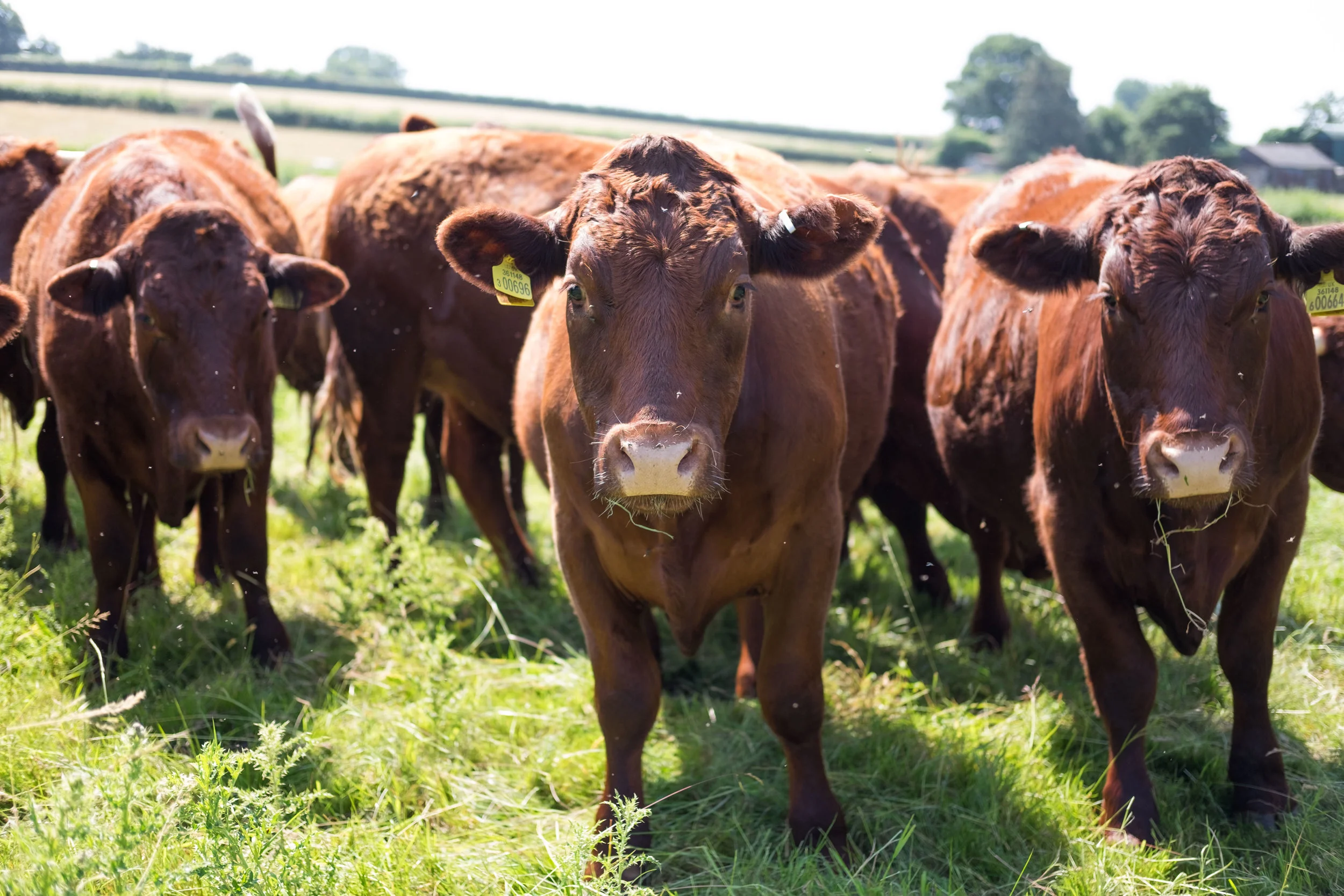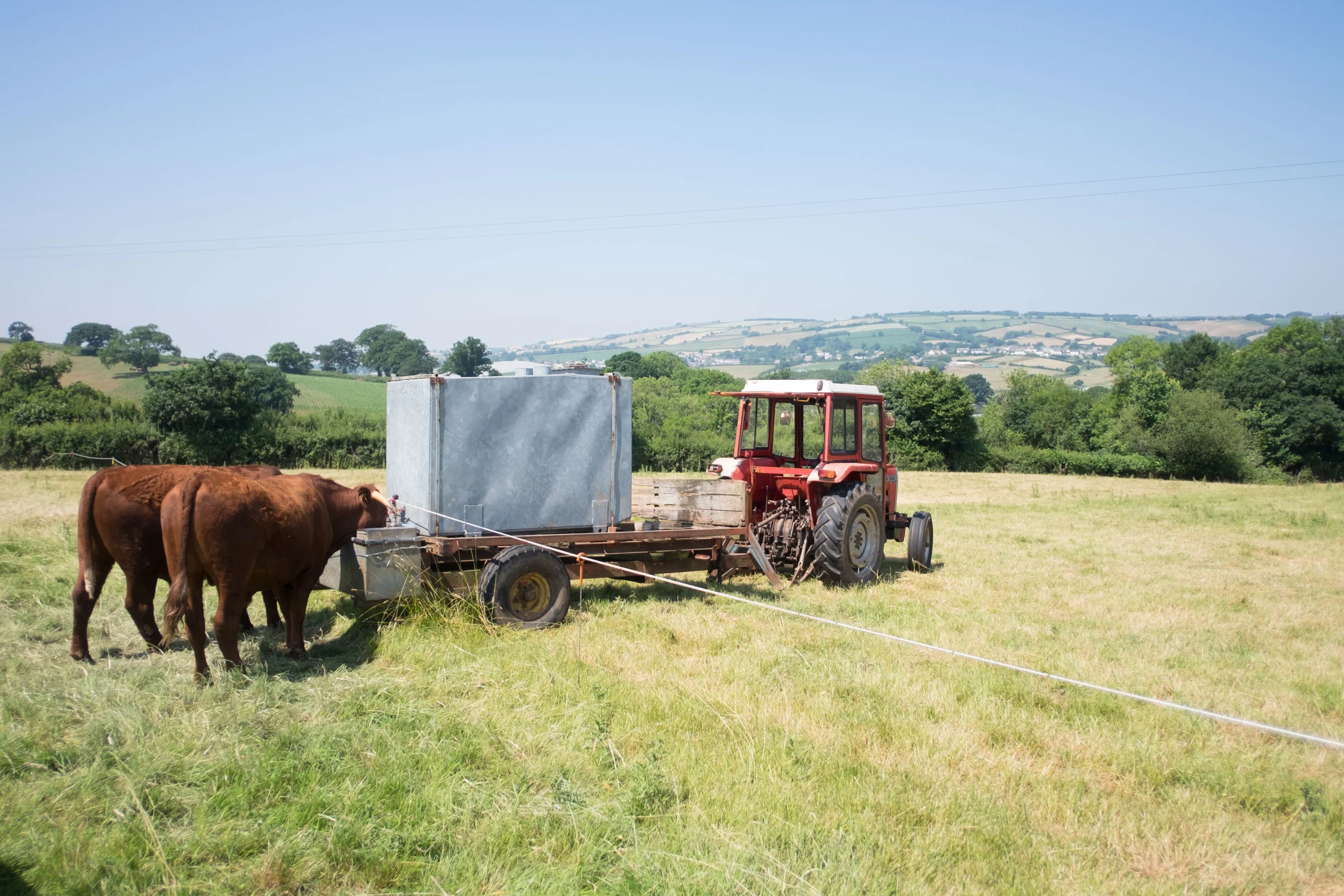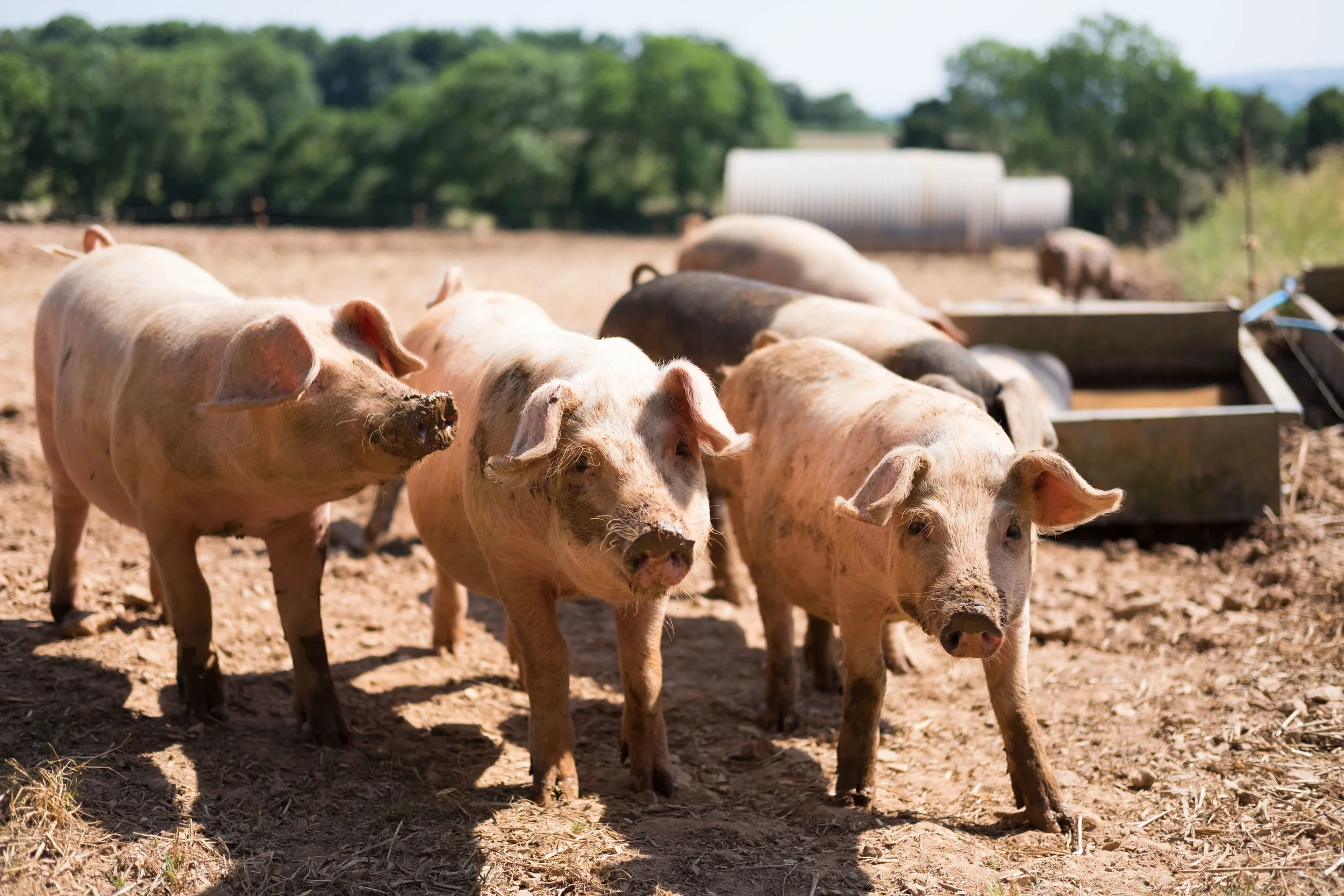PIPERS FARM
PRODUCE: PASTURE REARED MEAT
DISTANCE TO TABLE: 57.77 MILES
It’s a sunny Thursday when I arrive at the farm, early enough in the summer that the warm weather is still a novelty. I’d met Henri Grieg at a conference a few months earlier, and as I never turn down a farm visit opportunity, took her at her word when she invited me to come by sometime. Upon arrival, her husband Peter whisks me straight into their beautiful event space, complete with a farmhouse style table that stretches the whole way down the barn. The space smells of a heady fusion of hay from the bales I’m sat on, wildflowers from the table and smoke from the cooking pit, from which Peter is soon brandishing a platter of farm sausages, the perfect accompaniment to the giant pot of tea that Henri soon appears with.
Waiting for the tea to brew, I ask how Pipers Farm came to be; “We bought the farm 30 years ago,” Peter explains, telling me how when they were first married, himself and Henri had farmed on a high hill farm in Wensleydale before moving back to Peter’s family farm. “My dad pioneered industrial chickens,” Peter explains, going on to talk about how his family were growing half a million birds a year by 1987. “In 1952 it took about 54 days for my father to grow a 4lb chicken. In 1987 it was down to 36 days. Now, it takes 28 days,” he points out. “The point is, that figure is still falling, but the number of chickens in a shed is increasing.” At the same time, he watched the farming community around him change, with all the family farms he’d known as a child slowly ceasing to exist.
“We weren’t prepared to feed the chickens we were producing to our children, so we started looking for our own farm,” Peter continues, as Henri dishes out the tea and I munch on a second sausage, made from one of their own free-range chickens. “We looked at 80 farms in 6 months,” he tells me, describing the variety of properties they saw before finding the 52-acre property that would become known as Pipers Farm; “When we came here there was nothing except three tin sheds that they were milking cows in.” They got to work, knocking down the rather precarious bungalow on the site and living in a caravan while they built the farmhouse and set up a business. “We did it all ourselves – the farming, butchering, packaging,” he points out.
Their vision for the farm was clear from the start. “We knew we wanted to build a business that helped to sustain the fabric of smaller scale farming businesses,” he tells me. So rather than increasing the size of their own operation, they started approaching local farms about raising animals for them. “We started with our immediate neighbours, and then it gradually spread through the valley as we honed the system,” he continues, sipping on his tea; “Farming shouldn't be about producing bigger and bigger quantities. We want people to be able to produce a sustainable amount and maximise the market value. Our job is to make sure that every piece of meat arrives at the market with somebody who respects and appreciates the value of it so they get a proper price returned for their efforts.” Their network of small-scale local partners now extends to around 25 farms; “This was always our objective - we wanted it that every time a customer of ours buys a piece of meat, they are putting cash straight into smaller scale family farms.”
Teapot empty and thirst quenched, the much anticipated tour commences and we head off on foot to see some of their animals, the rhythmic chiming of chiff chaffs accompanying our walk through some nearby fields. “We have 52 acres on this farm,” Peter explains as we walk; “Five fields that run straight up the hill, and then four fields running along the bottom here.” He swings open a gate and we enter a large field divided up by electric fencing – the pasture raised farmer’s best friend. A herd of deep reddish brown cows start to amble down the field towards us. “We don't sell beef - we sell Red Ruby,” Peter explains, stepping over the electric fence and into the gathering herd. “Every mouthful is this breed, and it's the native Exmoor breed. That's what we as farmers should be doing - utilising and working within a living landscape that is part of where we farm.” Their acreage limits them to raising around 40 cattle on their land, but nearby farms are raising another 200 or so cows for them.
Across all the farms, their diet is a strict one; “Mother's milk and grass. That's it. To the end. No question,” Peter explains. He goes on to explain the role of the four stomachs that cows have. “The first two stomachs digest milk; to a small animal it's like rocketfuel! As they start to wean themselves off milk and onto grass, stomachs three and four come into play.” This is the point at which Peter really hits his stride, arms gesticulating wildly. “Their rumen is full of billions of bacteria, so when they bite the grass and swallow it, they put it into their rumen to mix it with their biome. Then they regurgitate it and ‘chew the cud’,” he continues, pointing out a bullock lying down, jaw gently rotating away. “They grind it with their molar teeth, and swallow it again, mix it up again, regurgitate it and keep chewing it. That process goes on until they know there is no nutritional value left.” And this is the point at which Peter does a very Peter like thing – he crouches down and starts prodding at a nearby cow pat. “We are feeding our cattle completely in harmony with their biome, which means when they are finished with the forage, it is itself in harmony with the wider biome – the cow pats on our farm disappear so quickly,” he continues, showing us the beetles and bugs nestled within.
It’s hard to leave the cows behind, their gentle and curious nature making them perfect photographic subjects. But Peter announces that it’s time for lunch and we return to the barn where the food is a wonderfully local affair; a beautiful piece of rump tail cooked over the fire, accompanied by a locally made loaf of bread and salad that another member of staff has grown, all topped off with a good glug of Henri’s famous salad dressing. The whole office team is packed around the table along with some other guests, and conversation focuses on the health benefits of pasture fed meat. “I feel that people are starting to understand more and more that what they're eating is impacting on their health, and they're actually concerned about their health,” Henri tells me as I reach for another helping of salad.
Appetite sated, there’s no time to dawdle. This time, we pile into their Landrover; three of us and a dog in the open back as Henri drives skilfully up a rather steep hill to the field at the top of their land. Fly, the dutiful sheepdog, rounds up some of their Suffolk sheep, aided by Peter’s expert direction and we all pause for a moment admiring the panoramic view over the surrounding area. Peter points out the boundary of their land, along with several neighbouring farms they work with. Conversation turns back to the sheep that Fly is still skilfully keeping in a tight herd. “One of the things that Henri and I believe in very deeply is the idea of consistency,” Peter points out, studying the animals in front of him. “These are Suffolk tups on a North of England mule, and all our sheep are raised exactly like this. We never kill a lamb less than 8 months old, and we kill them up to 15 months. In that window, hanging them for 3 weeks, we deliver absolute consistency. Once we worked out what Pipers Farm lamb was, every piece is the same.”
I ask how the business has grown over the past 30 years, conversation turns to their son Will returning to the family farm eight years ago. It represented a turning point in the business; “At that point, Henri and I were managing everything,” Peter points out. “It was a glass ceiling. We had no management resource to take it to another level.” With Will’s input, they restructured the business to bring on more staff and allow it to grow. “What Will’s had to do is implement a totally new structure, at home, under his parent’s feet – and that includes generational change too. I’ve got huge respect for him,” Peter admits, his admiration for his son evident in the way he speaks about the transition.
Back in the Landrover we go, bumping our way down a particularly narrow lane, ducking under low hanging branches while Peter regales us with tails of ancient roadways and local history. We set off in hunt of some pigs; nearby farmers Mark and David were dairy farmers before losing a quarter of their herd to TB. They sold their equipment and the rest of the cows, at which point Peter and Henri approached them about raising pigs. Peter tells us the backstory while sat on the tailgate of the vehicle as we race down country roads; “Mark is the younger generation; the energy, the future of the farm,” he points out, his foot casually wrapped around one of the hinges to keep his balance.
As we pull into the farm, we see Mark digging in some wallow troughs, a real kindness to the pigs in the heat of the summer. The large field is divided up into smaller sections, each containing a sow and piglets, who rush over to see who the new arrivals are. “We were milking about 120 cows on a robotic milking system, and the cows were predominantly indoors year-round,” Mark explains, turning to look at the field of pigs behind him. “With the pigs, we started off keeping some weaners, thinking we definitely wouldn’t keep any sows!” he tells me, smiling. “And we’ve somehow got to where we are – we’ve got just over 400 pigs and 15 sows!”
Peter joins in at this point; “They’ve always grown fodder beet as a crop, and the pigs work well alongside that.” Mark nods in agreement; “Pigs are obviously very good at clearing up waste, so where we harvest we can put the pigs along and they eat the waste on the ground,” he adds. Peter jumps back in; “It's going back to the system of mixed integrated farming systems - it's about marrying together enterprises that work for each individual farm. The pigs are feeding on the leftover fodder beet and in turn reducing fertilizer use and cultivation. And that's the common sense of a well-crafted mixed family farm - before farming became industrialised, all the farms in the valley would have had many different enterprises on them.”
Mark walks us up through the field, packs of piglets running alongside us, intrigued by our presence. I step inside to get some photographs and they scatter away from me before returning to sniff curiously around my ankles. It’s a hot day and the sows are bathing in whatever water they can find – either the newly dug wallow troughs, or simply in the mud around a water point.
As we drive back to the farm, I sit and watch the world go by; field after field of farmland whizzes past and I wonder how much of this area is still small-scale family farms. All too soon, we’re back at the farm and the day to day operations of the farm demand our hosts attention. “There are many farmers who are not doing what they would like to do, and we offer them an opportunity to change that,” Peter explains “We look at all the resources that a particular farm has to produce, and then we work out how we make the most of those resources.” And as Henri points out as we head off, “It's a win-win.”
Find out more: https://pipersfarm.com








